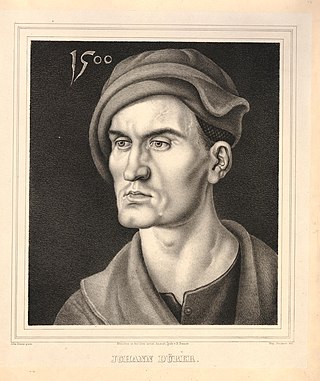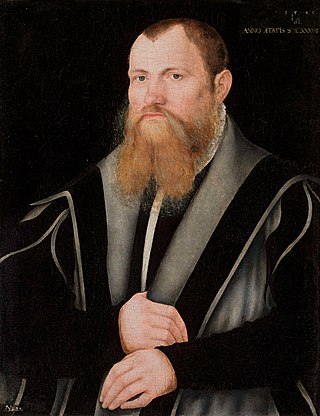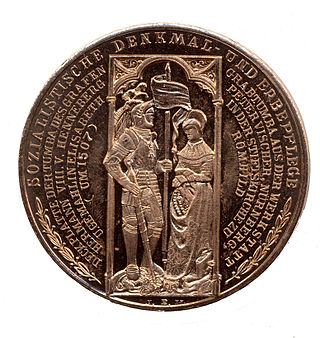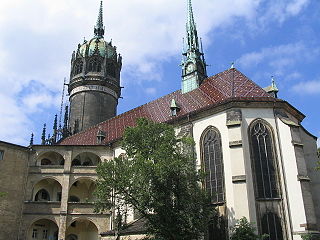
Albrecht III was Elector of Brandenburg from 1471 until his death, the third from the House of Hohenzollern. A member of the Order of the Swan, he received the cognomen Achilles because of his knightly qualities and virtues. He also ruled in the Franconian principalities of Ansbach from 1440 and Kulmbach from 1464.

Wittenberg, officially Lutherstadt Wittenberg, is the fourth-largest town in Saxony-Anhalt, Germany. It is situated on the River Elbe, 60 kilometers (37 mi) north of Leipzig and 90 kilometers (56 mi) south-west of Berlin, and has a population of 46,008 (2018).

Hans Dürer, was a German Renaissance painter, illustrator, and engraver.

Lucas Cranach the Younger was a German Renaissance painter and portraitist, the son of Lucas Cranach the Elder and brother of Hans Cranach.

Lucas Cranach the Elder was a German Renaissance painter and printmaker in woodcut and engraving. He was court painter to the Electors of Saxony for most of his career, and is known for his portraits, both of German princes and those of the leaders of the Protestant Reformation, whose cause he embraced with enthusiasm. He was a close friend of Martin Luther. Cranach also painted religious subjects, first in the Catholic tradition, and later trying to find new ways of conveying Lutheran religious concerns in art. He continued throughout his career to paint nude subjects drawn from mythology and religion.

The House of Fugger is a German family that was historically a prominent group of European bankers, members of the fifteenth- and sixteenth-century mercantile patriciate of Augsburg, international mercantile bankers, and venture capitalists. Alongside the Welser family, the Fugger family controlled much of the European economy in the sixteenth century and accumulated enormous wealth. The Fuggers held a near monopoly on the European copper market.
Peter Vischer may refer to:

Peter Vischer the Elder was a German sculptor, the son of Hermann Vischer, and the most notable member of the Vischer Family of Nuremberg.

Ernest, known as Ernst in German, was Elector of Saxony from 1464 to 1486.

Georg(e) Spalatin was the pseudonym taken by Georg Burkhardt, a German humanist, theologian, reformer, secretary of the Saxon Elector Frederick the Wise, as well as an important figure in the history of the Reformation.

Albert IV was Duke of Bavaria-Munich from 1467, and duke of the reunited Bavaria from 1503.

Römhild is a town in the district of Hildburghausen, in Thuringia, Germany. It is situated 14 km west of Hildburghausen, and 21 km southeast of Meiningen. On 31 December 2012, it merged with the former municipalities Gleichamberg, Haina, Mendhausen, Milz and Westenfeld.
Events from the year 1528 in art.
The decade of the 1480s in art involved some significant events.

Augustin Hirschvogel was a German artist, mathematician, and cartographer known primarily for his etchings. His thirty-five small landscape etchings, made between 1545 and 1549, assured him a place in the Danube School, a circle of artists in 16th-century Bavaria and Austria.

All Saints' Church, commonly referred to as Schlosskirche to distinguish it from the Stadtkirche of St. Mary's, sometimes known as the Reformation Memorial Church, is a Lutheran church in Wittenberg, Saxony-Anhalt, Germany. It is the site where, according to Philip Melanchthon, the Ninety-five Theses were posted by Martin Luther in 1517, launching the beginning of the Protestant Reformation.
Vischer is a surname. Notable people with the surname include:

John, known as John the Steadfast or John the Constant, was Elector of Saxony from 1525 until 1532 from the House of Wettin.
John IV, Landgrave of Leuchtenberg was Landgrave of Leuchtenberg from 1487 until his death. He was the son and heir of Landgrave Frederick V of Leuchtenberg and his wife Dorothea of Rieneck.

















